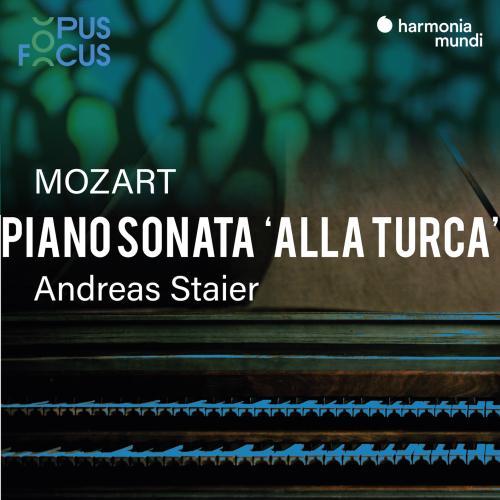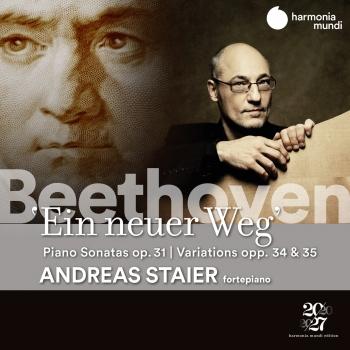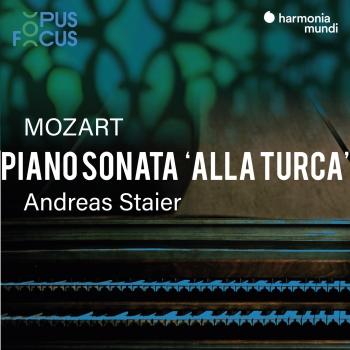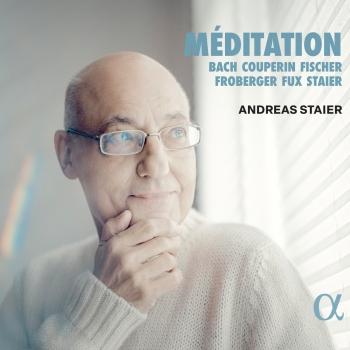
Mozart: Piano Sonata, K. 331 "Alla turca" Andreas Staier
Album info
Album-Release:
2020
HRA-Release:
26.06.2020
Label: Harmonia Mundi
Genre: Classical
Subgenre: Instrumental
Artist: Andreas Staier
Composer: Wolfgang Amadeus Mozart (1756-1791)
Album including Album cover
- Wolfgang Amadeus Mozart (1756 - 1791): Sonata in A Major, K.331:
- 1 Sonata in A Major, K.331: I. Theme and Variations (Andante grazioso) 12:37
- 2 Sonata in A Major, K.331: II. Menuetto - Trio 06:08
- 3 Sonata in A Major, K.331: III. Alla Turca (Allegretto) 03:38
Info for Mozart: Piano Sonata, K. 331 "Alla turca"
The opening movement of Mozart’s Piano Sonata K.331 is a theme and variations, a novel approach for a Viennese composer of the time. The work’s finale – the famous rondo ‘alla turca’ – which echoes the sound of Turkish Janissary bands (an idiom the composer also mined for his operatic Singspiel The Abduction from the Seraglio), is so stylized as to border on parody. Andreas Staier, performing on a fortepiano, delivers an exceptional reading full of poetry coupled with a good deal of fun in his choice of interpretative ideas.
"Imagine a musical whodunit where the solution is Andreas Staier on the fortepiano with pedal and his own ornamentation. The mystery is what is an excellent performance of some of Mozart's keyboard sonatas? Staier has exceptional musical judgment, which makes these sonatas graceful, but not too refined or elegant, and he also creates an outstanding balance between the serious and the lighthearted in their character. The three sonatas here are the ones believed to have been composed by Mozart in 1783 while visiting his family in Salzburg. The fortepiano greatly benefits the first one, K. 330 in C major, particularly in the final movement. Staier easily balances the two hands, whereas on a modern piano there is a tendency to give the left hand too much weight, making it louder than necessary. The use of pedal in the Trio of the second sonata's Menuet provides a great contrast to the Menuet proper. He gives the third sonata, another one that is prone to heaviness and sobriety, buoyancy and energy without being too theatrical. What really sticks out on this recording, and could be controversial depending on how you define "period performance," is the Rondo alla Turca. Because of the movement's ubiquity, Staier chose to change the ornamentation and even the lines of the music so that it is quite different from Mozart's original, but is in keeping with Mozart's compositional style. In other words, he improvised a new twist on a classic, as Mozart was known to have done. It has a wonderfully fresh, exciting sound to it, not just because it is unexpected, but also because Staier does things that Mozart didn't usually do in his sonatas, such as moving the entire melody to the bass line with sprightly punctuations in the right hand or creating counter-melodies that almost relegate the theme to an accompaniment. Mozart's sonatas are hard to play because of the innumerable interpretation decisions to be made. Staier's choices give these sonatas a naturalness in their sound and character that makes them a treat to hear." (Patsy Morita, AMG)
Andreas Staier, fortepiano
Andreas Staier
studied piano and gained his Baccalaureate in Göttingen, then went to Hanover where he studied piano, harpsichord and chamber music at the Staatliche Hochschule für Musik. It was whilst playing with the Hanover Conservatory Baroque Orchestra that Staier became acquainted with the harpsichord, and it was the discovery of the English repertoire, originally written for the virginal, that sparked him into deciding to study this instrument. He attended master-classes by Gustav Leonhardt and completed his studies at the Sweelinck Conservatory in Amsterdam with Ton Koopman where he graduated with distinction after two years.
In the early 1980s Staier was harpsichordist with Musica Antiqua Köln with whom he toured throughout Europe, North and South America, Australia, New Zealand and South East Asia. During this period he also concentrated on the study of the fortepiano.
A teaching post at the Schola Cantorum in Basle, Switzerland was combined with a performing career as soloist on the harpsichord and fortepiano, during which Staier appeared at Carnegie Hall in New York, Wigmore Hall in London, Suntory Hall in Japan and the Philharmonie in Berlin. He also appears regularly with the Freiburger Barockorchester, Concerto Köln, the Orchestre des Champs-Elysées and the Akademie für Alte Musik, Berlin. Staier is also in demand as an accompanist, and he works regularly with cellist Anner Bylsma and tenor Christoph Prégardien. He also appears at many of the best-known music festivals including La Roque d’Anthéron in France, the Montreux Festival in Switzerland and the Schleswig-Holstein in Germany.
Staier is one of the best fortepianists of the day. His performances are always interesting, and never sound dull, dry or boring in a musicological way. He does not try to educate the public into hearing how Mozart’s or Schubert’s music would have sounded to the composers, but by playing the music with taste, style and panache on perfectly regulated instruments, puts forward a case as good as any to hear these works on an alternative to the modern grand piano. One clue to his style may be found in an interview from July 1997 where he said, ‘When you hear recordings and piano rolls of Leschetizky or Moriz Rosenthal playing Liszt or Chopin they sound as if they’re composing the music themselves, playing with a kind of freedom, especially rhythmic freedom, which has nothing to do with a lack of respect, but gives a real insight into the music’s inner function…Unlike so many modern pianists, who sound as if they’re taking musical dictation, these older pianists play in musical gestures rather than individual notes. For me their playing is far more “authentic” than the mechanical interpretations you often hear today.’
Staier has recorded for BMG, and from 1995 to 2002 was under exclusive contract to Teldec Classics; after that he has recorded for Harmonia Mundi. For BMG, highlights include three volumes of selected sonatas and variations by Haydn recorded on an excellent-sounding instrument that is a 1982 copy of 1792 fortepiano. On the harpsichord Staier has recorded two volumes of sonatas by Scarlatti and there is a disc of works by C.P.E. Bach where he plays both harpsichord and fortepiano. For Teldec Staier has recorded piano concertos by Mozart, Salieri, Mendelssohn and John Field. Highlights of the solo recordings include a disc of music by William Byrd entitled John come kiss me now, Schubert’s last three piano sonatas on an original fortepiano from 1825, and lieder by Krufft, Lachner, Beethoven and Schubert with Christoph Prégardien. Of the Schubert sonatas Stephen Johnson wrote in The Gramophone, ‘As a final judgement, I’d say that this is the most impressive fortepiano recording I’ve heard. And that goes for the sound quality too.’ Staier’s recording of Schubert’s Die Winterreise with Christoph Prégardien also received glowing reviews. Alan Blyth found himself to be ‘…under the spell of this new version, finding it the most convincing of all, allied as it is to a finely balanced recording by West German Radio…’. After complimenting Prégardien, Blyth wrote, ‘Staier is just as revelatory…you have the sense of performers who have lived together with the cycle and conceived a unified, thought-through vision.’ Another solo disc titled Variaciones del fandango Español contains eighteenth century works Staier has unearthed in various libraries. For Harmonia Mundi Staier has recently recorded solo works by Mozart and some of Haydn’s concertos with the Freiburger Barockorchester.
This album contains no booklet.













